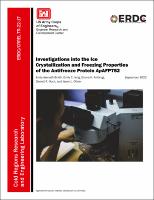Please use this identifier to cite or link to this item:
https://hdl.handle.net/11681/45620Full metadata record
| DC Field | Value | Language |
|---|---|---|
| dc.contributor.author | Asenath-Smith, Emily | - |
| dc.contributor.author | Jeng, Emily C. | - |
| dc.contributor.author | Ambrogi, Emma K. | - |
| dc.contributor.author | Hoch, Garrett R. | - |
| dc.contributor.author | Olivier, Jason L. | - |
| dc.creator | Cold Regions Research and Engineering Laboratory (U.S.) | - |
| dc.date.accessioned | 2022-09-30T13:40:34Z | - |
| dc.date.available | 2022-09-30T13:40:34Z | - |
| dc.date.issued | 2022-09 | - |
| dc.identifier.govdoc | ERDC/CRREL TR-22-17 | - |
| dc.identifier.uri | https://hdl.handle.net/11681/45620 | - |
| dc.identifier.uri | http://dx.doi.org/10.21079/11681/45620 | - |
| dc.description | Technical Report | en_US |
| dc.description.abstract | Antifreeze proteins (AFPs) allow biological organisms, including insects, fish, and plants, to survive in freezing temperatures. While in solution, AFPs impart cryoprotection by creating a thermal hysteresis (TH), imparting ice recrystallization inhibition (IRI), and providing dynamic ice shaping (DIS). To leverage these ice-modulating effects of AFPs in other scenarios, a range of icing assays were performed with AFPs to investigate how AFPs interact with ice formation when tethered to a surface. In this work, we studied ApAFP752, an AFP from the beetle Anatolica polita, and first investigated whether removing the fusion protein attached during protein expression would result in a difference in freezing behavior. We performed optical microscopy to examine ice-crystal shape, micro-structure, and the recrystallization behavior of frozen droplets of AFP solutions. We developed a surface chemistry approach to tether these proteins to glass surfaces and conducted droplet-freezing experiments to probe the interactions of these proteins with ice formed on those surfaces. In solution, ApAFP752 did not show any DIS or TH, but it did show IRI capabilities. In surface studies, the freezing of AFP droplets on clean glass surfaces showed no dependence on concentration, and the results from freezing water droplets on AFP-decorated surfaces were inconclusive. | en_US |
| dc.description.sponsorship | Goddard Space Flight Center. | en_US |
| dc.description.tableofcontents | Abstract .......................................................................................................................................................... ii Figures ............................................................................................................................................................ iv Preface ............................................................................................................................................................ vi 1 Introduction ............................................................................................................................................ 1 1.1 Background ..................................................................................................................... 1 1.2 Objectives ........................................................................................................................ 4 1.3 Approach ......................................................................................................................... 5 2 Experimental Methods......................................................................................................................... 6 2.1 Materials ......................................................................................................................... 6 2.2 Antifreeze protein (AFP) and ice microstructure study ................................................. 6 2.3 Ice recrystallization inhibition (IRI) studies via splat assay .......................................... 7 2.4 Dynamic ice shaping (DIS) ............................................................................................. 7 2.5 AFP solution droplet freezing in oil solutions ................................................................ 8 2.6 Freezing AFP droplets on glass surfaces ....................................................................... 8 2.7 Attaching AFPs to glass surfaces ................................................................................... 9 2.8 Attaching AFPs to surfaces: surface characterization ................................................ 10 2.9 Water-droplet-freezing experiments on surfaces with AFP ......................................... 10 3 Results ..................................................................................................................................................12 3.1 Effect of ApAFP752 on the microstructure of polycrystalline ice ............................... 12 3.2 Splat assay IRI with various AFPs ................................................................................ 13 3.3 DIS with various AFPs ................................................................................................... 14 3.4 Pseudohomogeneous freezing of ApAFP752 solutions ............................................. 17 3.5 Heterogeneous freezing of ApAFP752 solutions on clean glass surfaces ................ 18 3.6 Surface characterization for ApAFP752-functionalized surfaces .............................. 20 3.7 Heterogeneous freezing of water on functionalized surfaces .................................... 24 4 Discussion ............................................................................................................................................ 26 5 Conclusions .......................................................................................................................................... 28 References ................................................................................................................................................... 29 Abbreviations ............................................................................................................................................... 32 Report Documentation Page .................................................................................................................... 34 | - |
| dc.format.extent | 42 pages / 5.16 MB | - |
| dc.format.medium | - | |
| dc.language.iso | en_US | en_US |
| dc.publisher | Engineer Research and Development Center (U.S.) | en_US |
| dc.relation.ispartofseries | Technical Report (Engineer Research and Development Center (U.S.)) ; no. ERDC/CRREL TR-22-17 | - |
| dc.rights | Approved for Public Release; Distribution is Unlimited | - |
| dc.source | This Digital Resource was created in Microsoft Word and Adobe Acrobat | - |
| dc.subject | Antifreeze protein | en_US |
| dc.subject | Cryoprotection | en_US |
| dc.subject | Crystallization | en_US |
| dc.subject | Ice materials | en_US |
| dc.subject | Ice mechanics | en_US |
| dc.subject | Ice prevention and control | en_US |
| dc.subject | Ice recrystallization | en_US |
| dc.subject | Interfaces | en_US |
| dc.subject | Self-assembly | en_US |
| dc.subject | Surface chemistry | en_US |
| dc.title | Investigations into the ice crystallization and freezing properties of the antifreeze protein ApAFP752 | en_US |
| dc.type | Report | en_US |
| Appears in Collections: | Technical Report | |
Files in This Item:
| File | Description | Size | Format | |
|---|---|---|---|---|
| ERDC-CRREL TR-22-17.pdf | 5.16 MB | Adobe PDF |  View/Open |